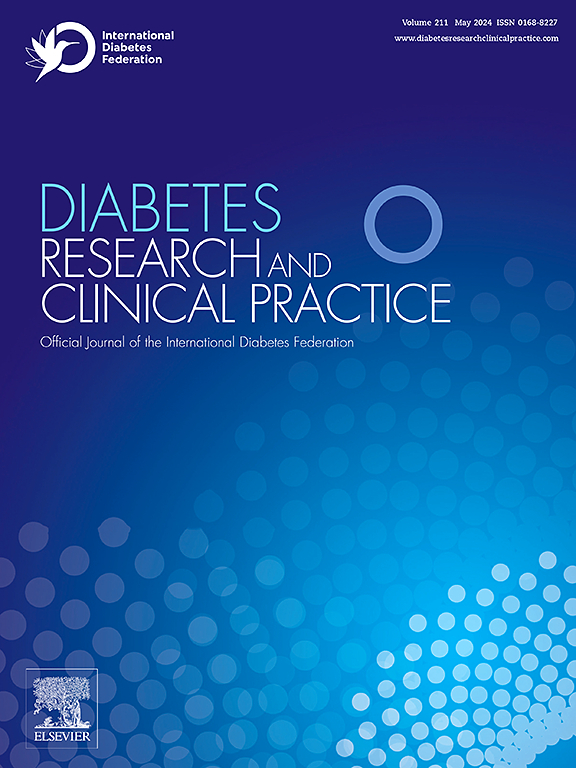有或无糖代谢异常的中老年人,特定情境下的静坐时间与抑郁症状的关联
IF 6.1
3区 医学
Q1 ENDOCRINOLOGY & METABOLISM
引用次数: 0
摘要
背景:静坐时间与抑郁症状之间的关系可能受到情境因素的影响,包括静坐的领域、类型和认知活动。在糖代谢异常(AGM)人群中对这些动态的研究是有限的。我们研究了有或没有AGM的成年人(IFG, IGT, T2D)的情境静坐时间与抑郁症状之间的关系。方法:数据来自AusDiab(2011- 2012),涉及4,614名成年人。用csd -10量表评估总坐着时间和情境特定坐着时间(工作、交通、休闲时间使用电脑和看电视)与抑郁症状之间的关系。结果:3834名参与者(59.3 岁;55.8% (女性),926(24.2% %)患有AGM, 120(13.0% %)报告抑郁症状。工作时久坐时间增加(OR 0.65, p )结论:心理被动久坐时间增加与抑郁症状有关,特别是在AGM患者中。减少被动坐姿可能有助于预防和管理T2D。本文章由计算机程序翻译,如有差异,请以英文原文为准。
Associations of context-specific sitting time with depressive symptoms in middle-aged and older adults with and without abnormal glucose metabolism
Background
The relationship between sitting time and depressive symptoms may be influenced by contextual factors, including the sitting domain, type, and cognitive activity. Research on these dynamics among people with abnormal glucose metabolism (AGM) is limited. We examined associations between contextual sitting time and depressive symptoms in adults with and without AGM (IFG, IGT, T2D).
Methods
Data were obtained from the AusDiab (2011–12), involving 4,614 adults. Associations between total and context-specific sitting time (work, transport, leisure-time computer use, and TV viewing) and depressive symptoms measured by the CESD-10 scale were assessed.
Results
Among 3,834 participants (59.3 years; 55.8 % women), 926 (24.2 %) had AGM, with 120 (13.0 %) reporting depressive symptoms. Increased sitting time at work (OR 0.65, p < 0.05) and transport (OR 0.76, p < 0.05) were inversely associated with depressive symptoms, while extended TV viewing (OR 1.46, p < 0.01) correlated positively. An interaction showed that those with AGM who engaged in leisure-time computer use for ≥ 0.9 h/day had lower odds of depressive symptoms compared to those sitting for 0–0.4 h/day (OR = 0.51, 95 % CI: 0.29–0.88, p < 0.05).
Conclusions
Increased mentally passive sitting time is linked to depressive symptoms, particularly in those with AGM. Reducing passive sitting may aid in T2D prevention and management.
求助全文
通过发布文献求助,成功后即可免费获取论文全文。
去求助
来源期刊

Diabetes research and clinical practice
医学-内分泌学与代谢
CiteScore
10.30
自引率
3.90%
发文量
862
审稿时长
32 days
期刊介绍:
Diabetes Research and Clinical Practice is an international journal for health-care providers and clinically oriented researchers that publishes high-quality original research articles and expert reviews in diabetes and related areas. The role of the journal is to provide a venue for dissemination of knowledge and discussion of topics related to diabetes clinical research and patient care. Topics of focus include translational science, genetics, immunology, nutrition, psychosocial research, epidemiology, prevention, socio-economic research, complications, new treatments, technologies and therapy.
 求助内容:
求助内容: 应助结果提醒方式:
应助结果提醒方式:


